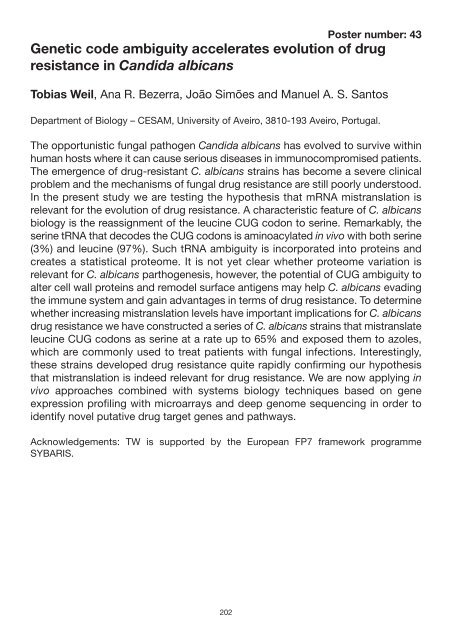Candida Infection Biology – fungal armoury, battlefields ... - FINSysB
Candida Infection Biology – fungal armoury, battlefields ... - FINSysB
Candida Infection Biology – fungal armoury, battlefields ... - FINSysB
You also want an ePaper? Increase the reach of your titles
YUMPU automatically turns print PDFs into web optimized ePapers that Google loves.
Poster number: 43<br />
Genetic code ambiguity accelerates evolution of drug<br />
resistance in <strong>Candida</strong> albicans<br />
Tobias Weil, Ana R. Bezerra, João Simões and Manuel A. S. Santos<br />
Department of <strong>Biology</strong> – CESAM, University of Aveiro, 3810-193 Aveiro, Portugal.<br />
The opportunistic <strong>fungal</strong> pathogen <strong>Candida</strong> albicans has evolved to survive within<br />
human hosts where it can cause serious diseases in immunocompromised patients.<br />
The emergence of drug-resistant C. albicans strains has become a severe clinical<br />
problem and the mechanisms of <strong>fungal</strong> drug resistance are still poorly understood.<br />
In the present study we are testing the hypothesis that mRNA mistranslation is<br />
relevant for the evolution of drug resistance. A characteristic feature of C. albicans<br />
biology is the reassignment of the leucine CUG codon to serine. Remarkably, the<br />
serine tRNA that decodes the CUG codons is aminoacylated in vivo with both serine<br />
(3%) and leucine (97%). Such tRNA ambiguity is incorporated into proteins and<br />
creates a statistical proteome. It is not yet clear whether proteome variation is<br />
relevant for C. albicans parthogenesis, however, the potential of CUG ambiguity to<br />
alter cell wall proteins and remodel surface antigens may help C. albicans evading<br />
the immune system and gain advantages in terms of drug resistance. To determine<br />
whether increasing mistranslation levels have important implications for C. albicans<br />
drug resistance we have constructed a series of C. albicans strains that mistranslate<br />
leucine CUG codons as serine at a rate up to 65% and exposed them to azoles,<br />
which are commonly used to treat patients with <strong>fungal</strong> infections. Interestingly,<br />
these strains developed drug resistance quite rapidly confirming our hypothesis<br />
that mistranslation is indeed relevant for drug resistance. We are now applying in<br />
vivo approaches combined with systems biology techniques based on gene<br />
expression profiling with microarrays and deep genome sequencing in order to<br />
identify novel putative drug target genes and pathways.<br />
Acknowledgements: TW is supported by the European FP7 framework programme<br />
SYBARIS.<br />
202


